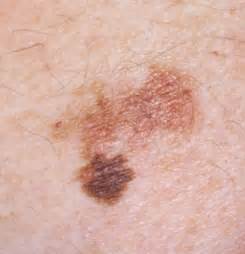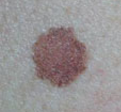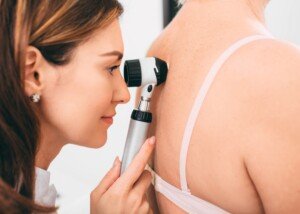
There’s far more to knowing about the borders of a melanoma than what you think.
First of all, a jagged border of a mole doesn’t always mean melanoma.
There are many variables to consider when scrutinizing the borders of your moles.
“Benign mole borders are usually smooth and well-defined,” says Caroline A. Chang, MD, a board certified dermatologist and founder of the Rhode Island Dermatology Institute.
Dr. Chang explains, “Suspicious mole borders are often fuzzy, scalloped, irregular, asymmetric.
“I have often heard melanomas recalled as having a fuzzy border or looking like a ‘splotch.’”
Using Magnifying Lenses to Inspect Moles
When you examine your moles for your monthly self-inspection, it’s advisable to abstain from using a magnifying glass, as this will accentuate jaggedness in the border of a benign mole that looks pretty normal without magnification.
Viewing magnified moles, which accentuates their features, can cause a lot of anxiety.
The more magnified a mole, the more “uneven” or “notched” the border appears to the layperson.
Every year I undergo elective serial digital dermoscopy, in which moles are photographed; the images are input into a computer database and rated for index of suspicion for melanoma.
I’ve seen my normal moles magnified on a computer screen – big images. The borders appear quite jagged under this magnification.
Even a simple magnifying glass can make a benign mole look suspicious for melanoma – to the untrained eye.
So don’t get into the habit of using magnifying glasses during self-exams. The only exception to this guideline is if you have presbyopia: blurry up-close vision that requires reading glasses.
This eye condition usually starts setting in in the mid-40s. It will prevent you from crisply viewing a mole if you’re up close and personal to it, such as with moles on your shin or forearm.
But people with good up-close vision really should not use any magnification lenses.
Has the Mole Always Had a Jagged Border?
If a mole’s border looks rather uneven or erratic to the naked eye, this is suspicious, but it doesn’t always mean melanoma.

Have a dermatologist inspect it with a dermatoscope. All moles, too, should be viewed through this dermatologist’s tool.
Conversely, sometimes melanomas have smooth borders. Or, the melanoma can be starting up in the center or inside the border of a mole that has a round smooth border.
Once you get acquainted with your moles, make a note of the ones with uneven or irregular borders.
The longer that time passes during which you don’t detect any changes in these moles, the more reassuring this will be that they’re benign.
But if you continue to worry, request a biopsy. It’s normal to keep wondering if a mole has always had particular border features.
Serial Digital Dermoscopy
You do not need to have a large number of moles or “funny looking” moles to have serial digital dermoscopy.
If you’ve been diagnosed with dysplastic nevi (funny looking moles), your insurance may cover serial digital dermoscopy.
If your insurance doesn’t, have it done anyways. The peace of mind is incredible, and this technology really does make a difference. The cost will be around $250.
The computer database may rate a mole in the “suspicious” category, leading to a biopsy that confirms a very early melanoma that was not evident to the naked eye or even through a dermatoscope.
The computer software can detect if a mole’s border needs further evaluation.



























